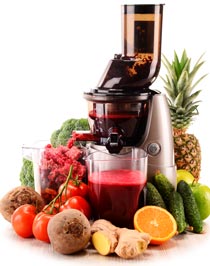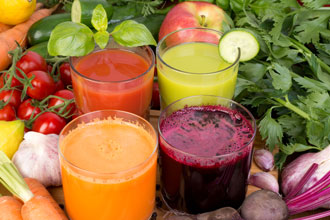Juicing is a convenient, tasty and time-saving way to incorporate fruits, vegetables and greens – and all of their beneficial nutrients – in your diet. It’s especially appealing to those who don’t care for eating vegetables, or have the time or inclination to prepare them.
If done right, juicing can give you a tremendous health boost. It can help you feel better, increase your energy, and even lose weight. But if you’re not careful, you could experience some setbacks on the road to juicing success.
Here are some suggestions to help you avoid some basic pitfalls, and get the most out of your juicing experience.
Buy the right juicer for YOUR particular needs.
You don’t have to spend a fortune to start reaping the benefits of juicing. On the other hand, if you purchase a juicer simply because you saw it on an infomercial or advertised at an outrageously discounted price, you’ll probably end up regretting it. Beware of all the advertising hype. The fact is, despite the claims, no single juicer does everything well.
Basically, juicers can be categorized into two types.
- Centrifugal Juicers
- Masticating Juicers
Because of their design, centrifugal juicers don’t perform well with drier, leafy greens and grasses. They’re optimized for juicing softer, wetter fruits and vegetables. While they work relatively fast, their rapidly spinning blades produce excess heat that can destroy some beneficial enzymes and nutrients. They also aren’t always the most efficient type of juice extractor, leaving some liquid behind in the pulp. However, some of the most affordable juicers are the centrifugal type.
 Masticating juicers, on the other hand, can easily process grasses and leafy greens. They’re also generally better at extracting more of the juice from the produce, resulting in drier pulp. Masticating juicers operate at a much slower speed than centrifugal models, and take longer to juice. But their slow speed doesn’t generate the destructive heat that centrifugal juicers do, preserving more of the beneficial enzymes and nutrients. While masticating juicers typically are more expensive than centrifugal models, they’re our personal favorites.
Masticating juicers, on the other hand, can easily process grasses and leafy greens. They’re also generally better at extracting more of the juice from the produce, resulting in drier pulp. Masticating juicers operate at a much slower speed than centrifugal models, and take longer to juice. But their slow speed doesn’t generate the destructive heat that centrifugal juicers do, preserving more of the beneficial enzymes and nutrients. While masticating juicers typically are more expensive than centrifugal models, they’re our personal favorites.
If speed and convenience are your main priority, a centrifugal juicer may be the right choice for you. If you’re interested in juicing leafy greens, and want the maximum juice yield and health benefit, we recommend a masticating juicer.
Our Favorite Masticating Juicers
Go natural, go fresh.
As the maxim goes, quality in, quality out. Juicing is only as nutritious as the ingredients you use. Whenever possible, buy organic: you’ll avoid unwanted pesticides. And always juice with the freshest possible produce – your juicer won’t cover up limp, soggy vegetables or mushy fruit. If you’re not already, become a regular at your local farmers market. If you buy your produce at a chain grocery store, be sure to wash it thoroughly before you juice with it. Juicing is another good reason to start, or expand, a home garden. There’s no fresher – and tastier – produce than that you pick right outside your door!
A few, carefully selected ingredients are best.
If you’ve ever seen a juicer being pitched in an infomercial or on a television shopping channel, they make it seem like you can randomly throw in handfuls of this and a few cups of that and a tablespoon of wheat germ and “Voila!” You’ve got a tasty juice! The reality is, it doesn’t quite work like that. When you combine more than 5-6 ingredients at a time, the flavors muddle and it all starts tasting the same. And that flavor isn’t particularly appetizing. Once you get the hang of juicing, you’ll get a feel for what your “base” ingredients are (e.g. cucumber, celery, apple, etc.), and what you can add on top of that to create a delicious juicing combination. Until then, it’s best to stick with tried-and-true recipes using 5-6 ingredients from a reputable source.
Mix up your juicing recipes.
 Like they say, variety is the spice of life. Each piece of produce contains its own unique combination of beneficial nutrients. These include vitamins, minerals, phytochemicals and antioxidants. The juicing process concentrates these nutrients, giving you a powerful nutritional punch. However, a few kinds of produce (including some bitter leafy greens, as well as cabbage, broccoli and cauliflower) contain trace amounts of naturally occurring substances that, if consumed in high concentrations over a prolonged period of time, may have a slight toxic effect. It’s best to stay on the safe side. By varying the fruits, vegetables and leafy greens in your juice every day, you’ll maximize your juicing health benefits.
Like they say, variety is the spice of life. Each piece of produce contains its own unique combination of beneficial nutrients. These include vitamins, minerals, phytochemicals and antioxidants. The juicing process concentrates these nutrients, giving you a powerful nutritional punch. However, a few kinds of produce (including some bitter leafy greens, as well as cabbage, broccoli and cauliflower) contain trace amounts of naturally occurring substances that, if consumed in high concentrations over a prolonged period of time, may have a slight toxic effect. It’s best to stay on the safe side. By varying the fruits, vegetables and leafy greens in your juice every day, you’ll maximize your juicing health benefits.
Start your day with a juice.
Remember that, optimally, juicing shouldn’t be used as a meal replacement, but as a meal supplement. For maximal nutrient absorption and health benefits, you should juice on an empty stomach, 20-30 minutes before a meal. That stated, the best time to juice is first thing in the morning, after you’ve fasted through the night. This way, the nutritional benefits of juicing start working immediately and last you all day long. If your schedule doesn’t permit that, the next best thing is to juice between meals, keeping the “empty stomach, 20-30 minutes before a meal” rule in mind.
Don’t gulp your juice – chew on it.
Juicing isn’t just about pumping high-octane “fuel” into your system. It’s better if you take it in slowly. Savor the experience. Think of all the hours you saved in the juicing process, then spend a little time enjoying it, while you soak in all the liquid goodness. Here’s another physiological and biochemical reason NOT to chug your juice: The digestion process starts in your mouth, with saliva, an important digestive enzyme that starts the process of unlocking all of those beneficial nutrients. To stimulate your saliva glands, take your juice a mouthful at a time. Swish it around several times, using a chewing motion, before you swallow. It may look a little funny to the uneducated, but you’ll be doing your digestive tract, and your taste buds, a favor.
Go easy on the greens.
 As previously mentioned, many leafy greens contain naturally occurring substances that potentially may be harmful if ingested in high concentrations over a long period of time. Additionally, most greens have a somewhat bitter taste that takes a little getting used to. But the benefits of leafy greens, juiced in moderation, far outweigh any potential negative side effects. So by all means, include leafy greens as a key element in your juicing. But as a general rule of thumb, limit them to 20-25% of your total juicing recipe mixture. And it’s also a safe bet to rotate your leafy greens each time you juice, selecting from a wide variety that’s typically available. In addition to the more “conventional” spinach, kale, chard and wheat grass, consider more “exotic” greens such as lamb’s quarter, mustard and dandelion greens, chicory and watercress. Get creative! See The Ultimate Guide to Green Juice for more detailed information and tasty recipes.
As previously mentioned, many leafy greens contain naturally occurring substances that potentially may be harmful if ingested in high concentrations over a long period of time. Additionally, most greens have a somewhat bitter taste that takes a little getting used to. But the benefits of leafy greens, juiced in moderation, far outweigh any potential negative side effects. So by all means, include leafy greens as a key element in your juicing. But as a general rule of thumb, limit them to 20-25% of your total juicing recipe mixture. And it’s also a safe bet to rotate your leafy greens each time you juice, selecting from a wide variety that’s typically available. In addition to the more “conventional” spinach, kale, chard and wheat grass, consider more “exotic” greens such as lamb’s quarter, mustard and dandelion greens, chicory and watercress. Get creative! See The Ultimate Guide to Green Juice for more detailed information and tasty recipes.
Limit sugary fruits and vegetables.
Fruits and some root vegetables like beets and carrots carry a high sugar content. And while natural fruit sugars may be more desirable to some than processed and refined white table sugar, the fact is: sugar is sugar. And the average U.S. consumer consumes entirely too much of it. In the immediate term, fruit-heavy juicing results in roller-coaster blood-sugar (and energy) spikes, followed by the inevitable crashes. In the long-term, heavy sugar consumption can lead to diabetes and/or unwanted weight gain. For the occasional “pick me up,” fruit-heavy juicing is fine. Otherwise, go easy on the sugar.
Drink what you juice.
With juicing, fresher is better. Juicing unlocks valuable nutrients. But those beneficial vitamins, minerals and phytochemicals come with an extremely short expiration date, which can be measured in hours, if not minutes. Once the juice comes out of your juicer, the clock starts ticking. It’s best to juice only what you intend to drink, and to drink it (slowly but) immediately. However, if you plan on taking juice with you to drink later (e.g. to work), then it’s fine to store it in a tightly sealed container like a thermos. As a general rule, you should drink anything you juice within 24 hours. And you should refrigerate whatever you don’t drink immediately, in a tightly sealed container.
A clean juicer is a happy juicer.
There are obvious health and sanitation reasons to always thoroughly clean your juicer after each use. You should also keep in mind that the natural sugars produced in juicing become extremely sticky and can easily obstruct moving parts if left to dry. Pulp clogs screens and accumulates in corners and crevices, and becomes extremely difficult to clean once it dries and becomes hard. At the very least, disassemble the juicer and place the washer-safe parts in a sink full of hot, soapy water immediately after each use. It will make cleaning them later much easier.




Leave a Comment